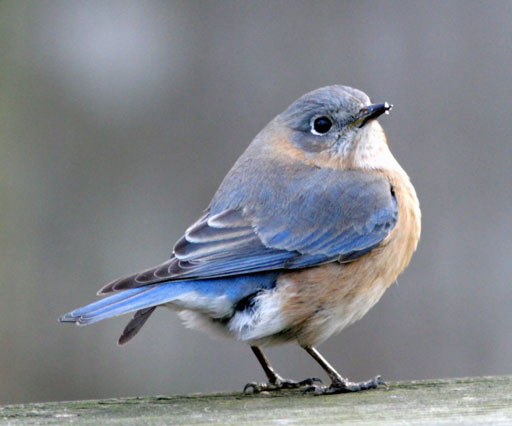Eastern Bluebird
From Wikipedia, the free encyclopedia
[Photo] Eastern Bluebird, female, Sialia sialis. Location: Durham County, North Carolina, United States. Date 2007-01-28. Author Patrick Coin (http://commons.wikimedia.org/wiki/User:Cotinis)
The Eastern Bluebird, Sialia sialis, is a medium-sized thrush found in open woodlands, farmlands and orchards.
Adults have a white belly. Adult males are bright blue on top and have a reddish brown throat and breast. Adult females have duller blue wings and tail, a brownish throat and breast and a grey crown and back. Eastern Bluebirds are found east of the Rockies, southern Canada to the Gulf States and southeastern Arizona to Nicaragua.
The bright blue breeding plumage of the male, easily observed on a wire or open perch, fluttering down to the mowed grass to capture a grasshopper, cricket or beetle makes this species a favorite of birders. The male's call includes sometimes soft warbles of jeew or chir-wi or the melodious song chiti WEEW wewidoo (Sibley, 2000).
Breeding
Eastern Bluebirds typically have two broods in the northern portions of their range while it is common for them to have three broods in the southern part of their range. In the case of the warm summer that lasts later than usual, three broods can be expected even in the Northeastern United States. The number of broods is mainly dependent on the weather and adequate availability of food (insects).
Eastern Bluebirds are secondary cavity nesters using an old woodpecker hole, natural cavity, hole in a rail fence or nesting box. It is common for the female to build a cupped-shaped nest made from dried grasses or pine needles and lined with finer grasses. She will then lay two to seven bluish or white eggs. White eggs are very uncommon, however. The eggs are incubated primarily by her, and will hatch in 12 to 14 days. The hatchlings are fed by both parents and the young ones fledge in another 14 to 20 days. Blowfly larvae are commonly found in bluebird nests but it is rare for the infestation to cause death of the hatchlings (by blood loss).
Conservation Status
The population of the Eastern Bluebird declined seriously enough in the past century to reach critical status by the mid-1900s. The decline was due to:
- Habitat destruction (loss of fields and nesting cavities in split-rail fences; clearing of dead trees)
- Pesticide use
- Nest predation by House Sparrows and European Starlings; both of which are non-native, introduced species
Fortunately, the species was rescued by a network of birding enthusiasts who erected nesting boxes for Bluebirds, with close monitoring necessary to prevent House Sparrows from nesting in them. They remain thoughtful of conservation, however, with competition still prevalent from other species (for e.g. Tree Swallows, which are a native species and which also nest in cavities) and in certain states of the US they can still be difficult to spot. It is worth noting that due to the increase in their numbers in the past few decades, they are not protected under CITES or U.S. Endangered Species Act.
The Bluebird is the state bird of Missouri and New York.
The Eastern Bluebird is also found in Bermuda, where the population may constitute a sub-species. Bermuda Bluebirds have become endangered by the loss of 8 million Bermuda cedar trees in the 1940s, and by nest predation from introduced Sparrows, Starlings, and Kiskadees. Kiskadees, introduced in 1957, have also contributed to declines of other species, such as the Cardinal and the Catbird. In 1987, Hurricane Emily destroyed much of Bermuda's forest habitat, adversely affecting the Bluebird and other tree-dependent species.
http://en.wikipedia.org/wiki/Eastern_Bluebird
| The text in this page is based on the copyrighted Wikipedia article shown in above URL. It is used under the GNU Free Documentation License. You may redistribute it, verbatim or modified, providing that you comply with the terms of the GFDL. |
|

